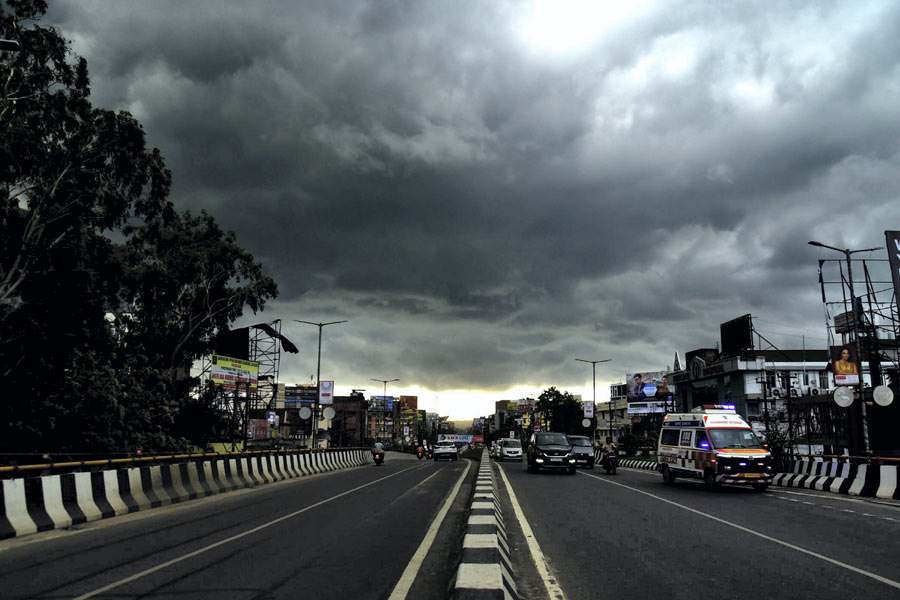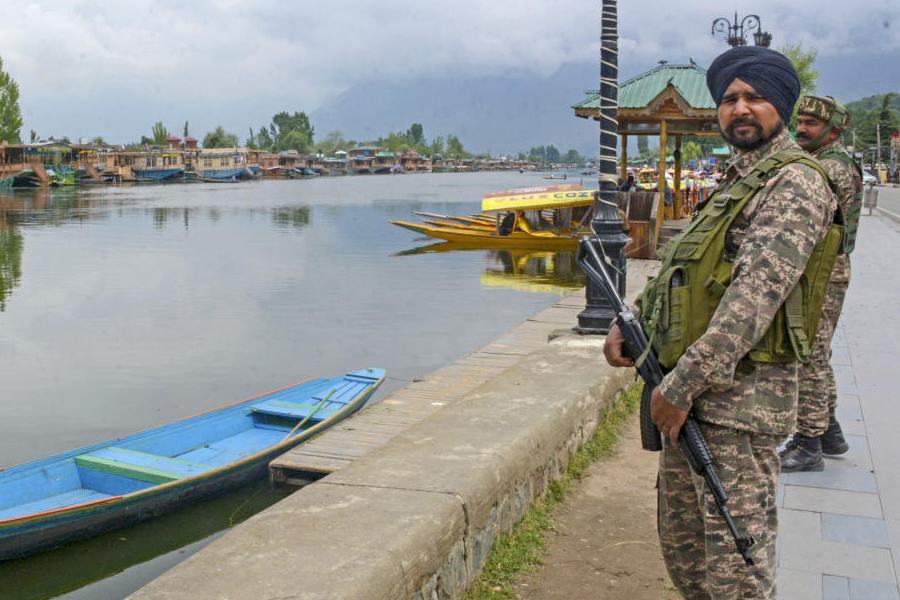 |
 |
 |
 |
 |
| (From top): A boomslang snake peers out through a Silver Clusterleaf shrub at Kruger National Park; a giraffe walks tall; a black rhino makes its way through the forest; an impala takes a water break; guide Kenneth Zwane points out leopard pugmarks to the tour group |
It was a steaming pile of rhino dung, seething with flies and dung beetles so energetic that the whole mound seemed to be in motion. Gifts sometimes come in unexpected forms. As we clustered around the dung heap, our guide pointed out a nearby rhino rubbing spot ? a fallen tree with a knobby branch rubbed smooth by repeated rhino scratching. The trail of flattened grass leading away from the midden told us where the beast had headed. We fell in line behind our guides Kenneth and John, both very careful, guns at the ready, silently following the tracks.
The trail led to a clearing and there they were, barely 40 feet away in plain view, not one but five white rhinoceros. A gigantic male hulk, a female, a younger male to the side and two others lying down. The female saw us and moved uneasily, the young male paid us no attention, but big daddy turned around to face us, ready to charge if provoked. He was large, close and extremely capable of trampling us to instant death. Two long minutes passed as we watched each other and then our guides shepherded us away to a safer, more distant viewing spot. I walked in a daze, still filled with the wonder that encounters of the wild kind inspire.
I was one of six tourists being led by Kenneth Zwane and John Mahumane on a wilderness trail through Kruger National Park in South Africa. Most people tour Kruger by road, often rushing from one large mammal to another in noisy SUVs. It’s a great way to see a lot of wildlife quickly and comfortably, perhaps all in the space of a single day. It is also the best bet for seeing lions, elephants, cheetahs, Cape Buffalo and rhinos ? the Big Five ? for which Kruger is famous. But the beauty of the bushveld, the rolling expanse of 20,000 sq km of grassland and scrub forest, is best savoured on foot. Walking through this landscape with its changing light and air, smells and sounds, is an experience of a lifetime. Add excellent guides and the promise of wildlife up close and you’re in nature lovers’ paradise. For a moderate fee, the Park service takes visitors on three-hour hikes in the morning and evening and I booked myself on these during my stay at Kruger.
It was pitch dark when we set off at 5am. The Southern Cross and Scorpio shone brilliantly overhead. A chilly but brief jeep ride took us from our camp, Berg-en-Dal into the wild. We stopped as the first fingers of red began streaking across the horizon, dawn on the bushveld.
Low rolling hills, grasses, bushes and small trees with the occasional giant-like Marula tree, stretched out for miles and miles. Hyena howls echoed in the distance, calling off a busy night of scavenging. As we alighted from the jeep, John and Kenneth loaded their rifles and gave each of us a water canteen and instructions on how to behave: walk single file, do not talk, and listen to the man with the loaded gun.
Then we were off on a narrow trail through the grass. Within minutes, our shoes were drenched with dew and hundreds of grass seeds clung onto our trousers, socks and shoes, while insects enthusiastically buzzed about. Kenneth set an easy pace, stopping every 15 minutes or so to point out or explain something. He and John were like walking National Geographic encyclopaedias ? from the sex life of the golden orb spider to the territorial habits of the rhino and to the number of vertebrae in a giraffe’s neck (seven, same as a human), they made everything we came across fascinating and fun.
And we came across a lot more than the rhinoceros. We were heading east and the sun’s early rays hit the dew on the knee-high grass to create a shimmering light all around us. A herd of impala went into high alert at our approach, each slender animal tautly ready to run, its white ears pricked and almost quivering with tension. They stood in a frozen tableau, watching intently till we walked away. The three zebras that we came across were similarly wary, the muscles in their powerful hind quarters bunched up ready to gallop away.
We kept going, now passing into denser bush. John stopped at a small Silver Clusterleaf shrub at breast height. I peered at the green leaves along with the others but couldn’t make anything out. I followed John’s pointing finger and then saw, incredibly well camouflaged, a boomslang or tree snake. Though it is venomous, we were safe because the morning chill made it sluggish and slow to take offence. But the day was warming up and we strode away, past trees stripped of their bark by elephants, past clumps of glowing red zinnia flowers, alas an invasive species, towards a rocky outcrop. We took a short break on a ledge overlooking the green veld below. A dwarf mongoose, dark shiny brown, emerged from behind a rock, its beady eyes following our movements.
Our guides opened a backpack and spread out a napkin and presented us with our ‘bush breakfast’ ? juice packets, beef jerky, peanuts and raisins, and chewy chocolate cookies. Nice! We sat and munched, gazing out over the park and then resumed our walk, now looping back to the jeep.
Throughout our walk we were accompanied by a loud, harsh croaking call. Kenneth identified it as the Cape turtle-dove. According to the guide, in the day the turtle-dove calls ‘Work ha-rder, work ha-rder’ and in the evening, ‘Drink la-ger drink la-ger’. The turtle-doves were the first of the many birds we saw and heard. Our progress on the trail flushed out flocks of Natal francolins that burst into laboured flight. Parties of yellow-billed hornbills ? John called them flying bananas ? flapped past overhead. I was pleased to spot a golden-tailed woodpecker dashing to a tree-trunk close by. Fiscal flycatchers flew in and out of trees, golden-breasted buntings sang atop bushes, and brown-headed parrots cackled and shrieked past in the sky.
I would have loved to linger and train my binoculars for a closer look, but time was flying too and our walk would soon be over. Just as we were heading towards the jeep, we saw a giraffe in the distance casually munching on leaves. Tiny red-billed oxpeckers hopped up and down its body, pecking at insects and mites, a crew of personal attendants doing a very thorough grooming job. A little further, we came across a male African elephant, a tusker, jet-black from having freshly rolled in wet mud. It ambled along with its giant ears flapping (to cool the large vascular arteries in the ears), moving through the undergrowth with a majestic rolling gait, stopping every now and then to taste the occasional tree.
But then it was time to pile into the jeep and head back to camp. Dishevelled and damp, we disembarked at our rustic bungalows and wrung John and Kenneth’s hands in heartfelt thanks. Hot breakfasts and strong coffee awaited us, the perfect end to a vigorous tramp through the bush. And soon enough, showered and rested, we were ready for another walk in the wilderness.
Photographs of boomslang snake and tour group by the author











